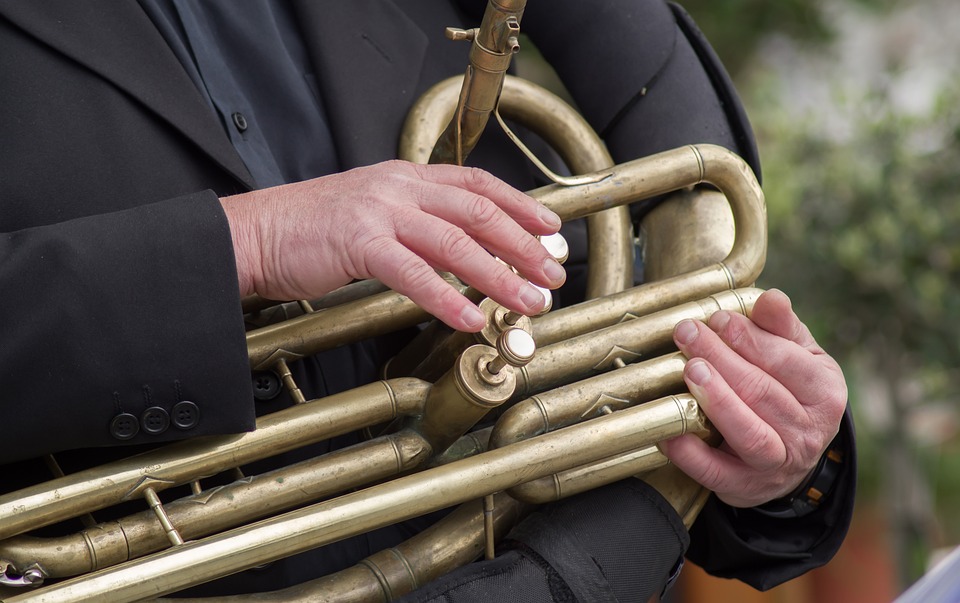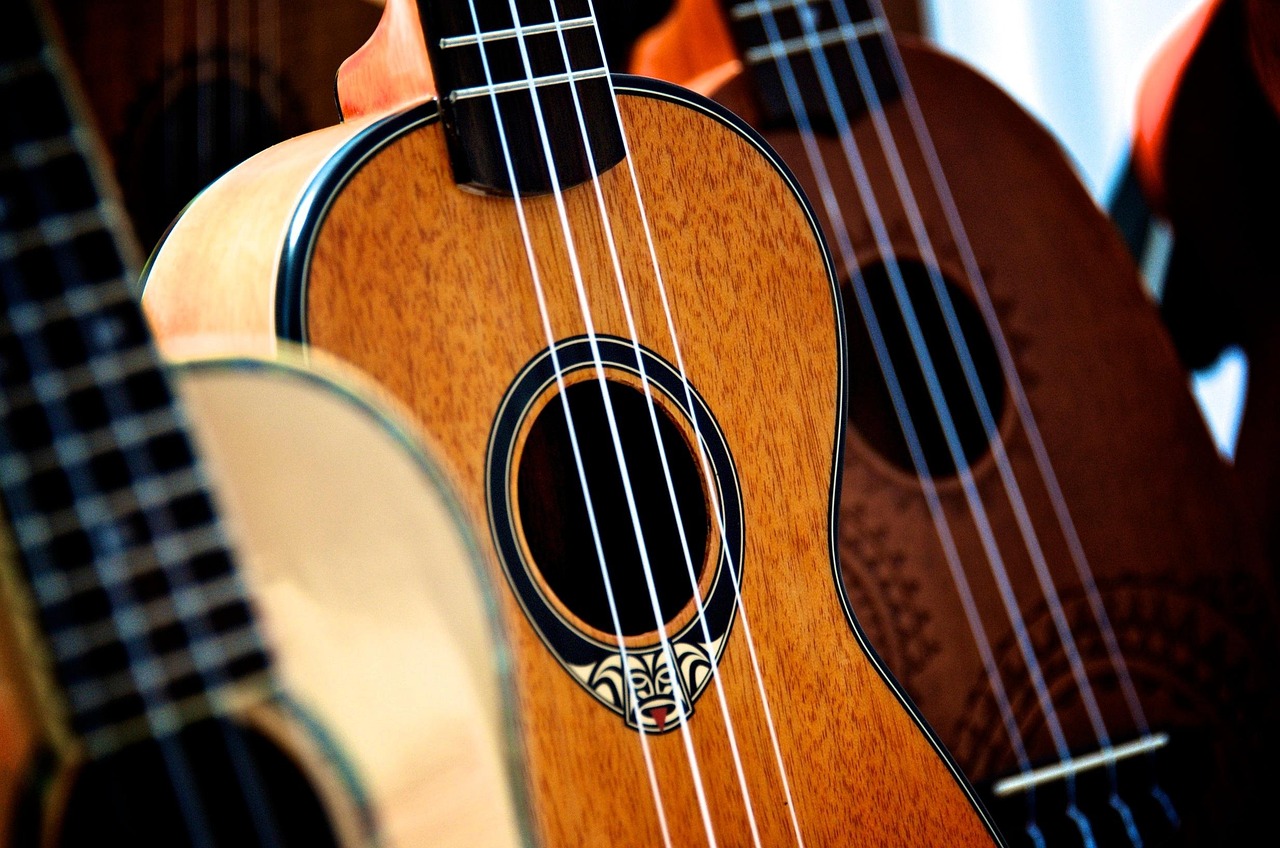Mastering the Ukulele: Your Complete Guide to Ukulele Chord Charts
Janvi Arora
- 22 January, 2025
- 15 min read
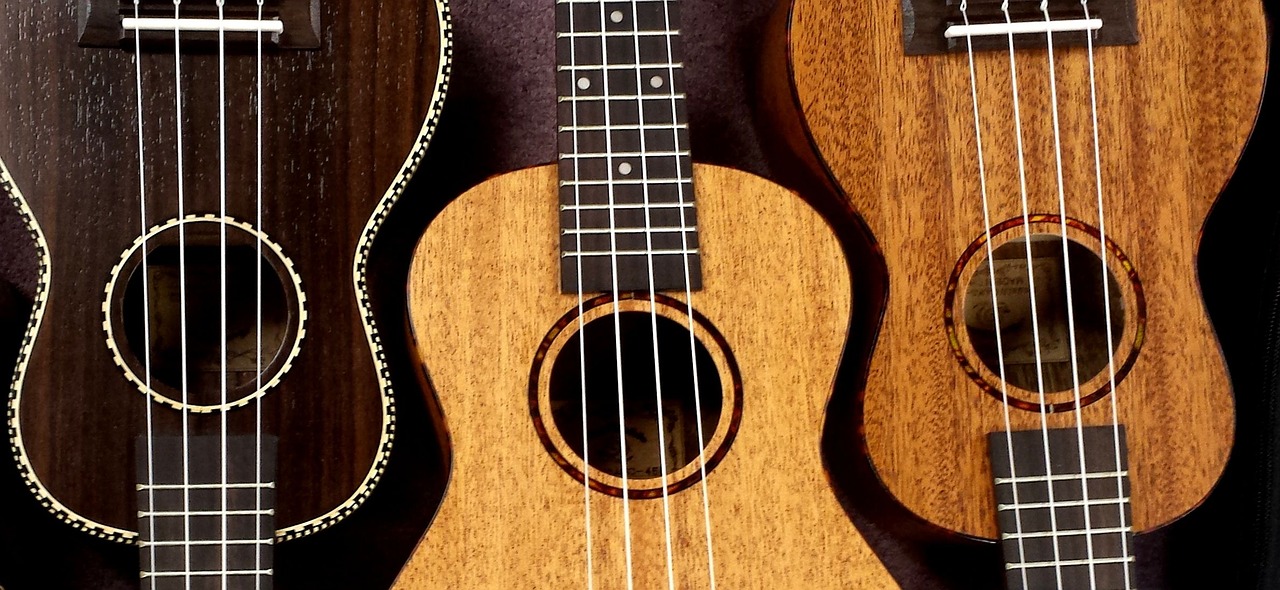
Table of Contents
The ukulele is a delightful and accessible instrument that has charmed its way into the hearts of musicians worldwide. Whether you are a beginner or looking to expand your repertoire to understand ukulele chords is essential. This guide will walk you through everything you need to know about uke chord charts, from the basics to more advanced chords.
What are Ukulele Chords?
Ukulele chords are groups of notes played together to produce a harmonious sound. Each chord is a beautiful combination of specific notes that complement each other, creating a distinct sound. Chords are the foundation of playing songs on the ukulele.
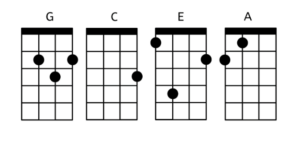
Understanding Ukulele Chord Charts
Ukulele chord charts are visual representations of how to play chords on the ukulele. These charts show the four strings of a ukulele (G, C, E, A) and indicate where to place your fingers on the fretboard. Each diagram includes vertical lines representing the strings, horizontal lines representing the frets, and dots or numbers indicating finger positions.
Exploring Common Ukulele Chords
Learning common ukulele chords is the first step toward mastering the instrument. Here, we will cover the most frequently used chords and how to play them.
Ukulele Major Chords
Major chords are bright and happy-sounding chords:
C Major: Place your ring finger on the third fret of the A string.
D Major: Place your index finger on the second fret of the G string, your middle finger on the second fret of the C string, and your ring finger on the second fret of the E string.
E Major: Place your index finger on the first fret of the G string, your middle finger on the second fret of the C string, and your ring finger on the fourth fret of the E string.
F Major: Place your index finger on the first fret of the E string and your middle finger on the second fret of the G string.
G Major: Place your index finger on the second fret of the C string, your middle finger on the second fret of the A string, and your ring finger on the third fret of the E string.
A Major: Place your index finger on the first fret of the C string and your middle finger on the second fret of the G string.
B Major: Place your index finger on the second fret of the A string, your middle finger on the third fret of the C string, and your ring finger on the fourth fret of the G string.
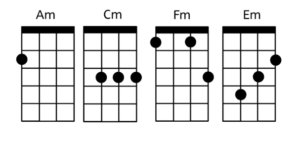
Ukulele Minor Chords
Minor chords have a sadder or more sombre tone. Some of the most common minor chords are:
C Minor (Cm): Place your index finger across the third fret of the G, C, E, and A strings.
D Minor (Dm): Place your index finger on the first fret of the E string, your middle finger on the second fret of the G string, and your ring finger on the second fret of the C string.
E Minor (Em): Place your index finger on the second fret of the A string, your middle finger on the third fret of the E string, and your ring finger on the fourth fret of the C string.
F Minor (Fm): Place your index finger across the first fret of the G, C, E, and A strings.
G Minor (Gm): Place your index finger on the first fret of the A string, your middle finger on the second fret of the C string, and your ring finger on the third fret of the E string.
A Minor (Am): Place your middle finger on the second fret of the G string.
B Minor (Bm): Place your index finger across the second fret of the G, C, E, and A strings and your ring finger on the fourth fret of the G string.
Ukulele Seventh Chords
Seventh chords add a bit of tension and complexity to your music. Here are some common seventh chords:
C7: Place your index finger on the first fret of the A string.
D7: Place your index finger on the second fret of the G string and your middle finger on the second fret of the E string.
E7: Place your index finger on the first fret of the G string, your middle finger on the second fret of the C string, and your ring finger on the second fret of the A string.
F7: Place your index finger on the first fret of the E string, your middle finger on the second fret of the G string, and your ring finger on the third fret of the C string.
G7: Place your index finger on the first fret of the E string, your middle finger on the second fret of the C string, and your ring finger on the second fret of the A string.
A7: Place your index finger on the first fret of the C string.
B7: Place your index finger on the second fret of the G string, your middle finger on the second fret of the C string, your ring finger on the second fret of the E string, and your pinky finger on the second fret of the A string.

Ukulele Major Seventh Chords
Major seventh chords have a jazzy and smooth sound. Here is how to play a few:
C-maj7: Place your index finger on the second fret of the A string.
D-maj7: Place your index finger on the second fret of the G string, your middle finger on the second fret of the C string, your ring finger on the second fret of the E string, and your pinky finger on the second fret of the A string.
E-maj7: Place your index finger on the first fret of the G string, your middle finger on the second fret of the C string, your ring finger on the third fret of the E string, and your pinky finger on the fourth fret of the A string.
F-maj7: Place your index finger on the first fret of the E string, your middle finger on the second fret of the G string, and your ring finger on the second fret of the C string.
G-maj7: Place your index finger on the second fret of the C string, your middle finger on the second fret of the E string, and your ring finger on the second fret of the A string.
A-maj7: Place your index finger on the first fret of the C string, your middle finger on the second fret of the G string, your ring finger on the second fret of the E string, and your pinky finger on the second fret of the A string.
B-maj7: Place your index finger on the second fret of the A string, your middle finger on the third fret of the C string, your ring finger on the fourth fret of the G string, and your pinky finger on the fourth fret of the E string.
Ukulele Minor Seventh Chords
Minor seventh chords combine the sound of minor chords with the complexity of seventh chords:
C m7: Place your index finger across the third fret of the G, C, E, and A strings.
D m7: Place your index finger on the first fret of the E string, your middle finger on the second fret of the G string, and your ring finger on the second fret of the C string.
E m7: Place your index finger on the second fret of the C string and your middle finger on the second fret of the A string.
F m7: Place your index finger across the first fret of the G, C, E, and A strings and your ring finger on the third fret of the C string.
G m7: Place your index finger on the first fret of the A string, your middle finger on the second fret of the C string, your ring finger on the third fret of the E string, and your pinky finger on the third fret of the G string.
A m7: Strum all open strings.
B m7: Place your index finger across the second fret of the G, C, E, and A strings and your ring finger on the fourth fret of the E string.

Ukulele Dominant Seventh Chords
Dominant seventh chords are versatile and commonly used in blues and jazz:
C7: Place your index finger on the first fret of the A string.
D7: Place your index finger on the second fret of the G string and your middle finger on the second fret of the E string.
E7: Place your index finger on the first fret of the G string, your middle finger on the second fret of the C string, and your ring finger on the second fret of the A string.
F7: Place your index finger on the first fret of the E string, your middle finger on the second fret of the G string, and your ring finger on the third fret of the C string.
G7: Place your index finger on the first fret of the E string, your middle finger on the second fret of the C string, and your ring finger on the second fret of the A string.
A7: Place your index finger on the first fret of the C string.
B7: Place your index finger on the second fret of the G string, your middle finger on the second fret of the C string, your ring finger on the second fret of the E string, and your pinky finger on the second fret of the A string.
Ukulele Suspended Chords
Suspended chords create a sense of anticipation or suspension in music:
C-sus2: Place your index finger on the first fret of the E string and your middle finger on the second fret of the A string.
C-sus4: Place your index finger on the first fret of the E string and your ring finger on the third fret of the A string.
D-sus2: Place your index finger on the second fret of the G string and your middle finger on the second fret of the C string.
D-sus4: Place your index finger on the second fret of the G string and your ring finger on the third fret of the E string.
E-sus2: Place your index finger on the second fret of the A string and your middle finger on the fourth fret of the E string.
E-sus4: Place your index finger on the second fret of the A string and your middle finger on the second fret of the D string.
F-sus2: Place your index finger on the first fret of the E string and your middle finger on the third fret of the A string.
F-sus4: Place your index finger on the first fret of the E string and your ring finger on the third fret of the A string.
G-sus2: Place your index finger on the first fret of the E string and your middle finger on the second fret of the A string.
G-sus4: Place your index finger on the first fret of the E string and your ring finger on the third fret of the A string.
A-sus2: Place your index finger on the second fret of the G string and your middle finger on the second fret of the C string.
A-sus4: Place your index finger on the second fret of the G string and your ring finger on the third fret of the E string.
B-sus2: Place your index finger on the second fret of the A string and your middle finger on the fourth fret of the E string.
B-sus4: Place your index finger on the second fret of the A string and your middle finger on the fourth fret of the D string.
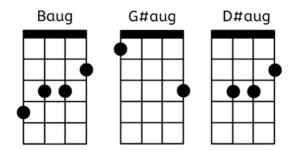
Ukulele Diminished and Augmented Chords
Diminished and augmented chords add a unique tension and complexity to your playing:
C-diminished: Place your index finger on the first fret of the G string, your middle finger on the second fret of the C string, and your ring finger on the third fret of the E string.
D- diminished: Place your index finger on the first fret of the A string, your middle finger on the second fret of the C string, and your ring finger on the second fret of the E string.
E- diminished: Place your index finger on the first fret of the G string, your middle finger on the second fret of the C string, and your ring finger on the third fret of the E string.
F- diminished: Place your index finger on the first fret of the A string, your middle finger on the second fret of the C string, and your ring finger on the third fret of the E string.
G- diminished: Place your index finger on the first fret of the G string, your middle finger on the second fret of the C string, and your ring finger on the third fret of the E string.
A- diminished: Place your index finger on the first fret of the A string, your middle finger on the second fret of the C string, and your ring finger on the second fret of the E string.
B- diminished: Place your index finger on the first fret of the A string, your middle finger on the second fret of the C string, and your ring finger on the second fret of the E string.
C-augmented: Place your index finger on the first fret of the G string, your middle finger on the second fret of the C string, and your ring finger on the third fret of the E string.
D-augmented: Place your index finger on the second fret of the G string, your middle finger on the third fret of the C string, and your ring finger on the fourth fret of the E string.
E-augmented: Place your index finger on the second fret of the G string, your middle finger on the third fret of the C string, and your ring finger on the fourth fret of the E string.
F-augmented: Place your index finger on the first fret of the G string, your middle finger on the second fret of the C string, and your ring finger on the third fret of the E string.
G-augmented: Place your index finger on the second fret of the G string, your middle finger on the third fret of the C string, and your ring finger on the fourth fret of the E string.
A-augmented: Place your index finger on the second fret of the G string, your middle finger on the third fret of the C string, and your ring finger on the fourth fret of the E string.
B-augmented: Place your index finger on the second fret of the G string, your middle finger on the third fret of the C string, and your ring finger on the fourth fret of the E string.

Tips to Learn and Practice Ukulele Chord Charts
1. Start Slow: Start by learning a few basic chords and practising slow transitions for the correct placements. Sore fingers are a common experience for beginners; build calluses by practising regularly and consider taking breaks if the pain becomes too intense. Over time, your fingers will adapt, and the soreness will diminish.
2. Use a Metronome: Practice with a metronome to develop your sense of timing and rhythm. Start slow and gradually increase the speed as you get comfortable.
3. Practice Regularly: Consistency is the key. Aim for daily practice sessions, even if they are short. It reinforces your muscle memory and improves your chord transitions.
4. Learn Songs You Enjoy: Apply the chords you learn by playing songs you enjoy. It makes practice more enjoyable and helps you see how chords get played in real music.
5. Seek Feedback: If possible, play for others or record yourself to get feedback. It can help you identify areas for improvement.
6. Join a Community: Join online forums, local ukulele groups, or social media communities. Connecting with other ukulele players can provide support, motivation, and additional learning resources.
7. Be Patient: Learning an instrument takes time and persistence. Celebrate your progress, no matter how small, and keep pushing forward.
By mastering these chords and regularly practising, you’ll be well on your way to becoming a proficient ukulele player. Remember, the journey of learning music is as rewarding as the destination.
While we are preparing to launch ukulele lessons on Torrins, you can explore our extensive library of courses on piano, bass, and guitars. The chord construction for the ukulele is similar to that of a guitar. You can check out our Guitar Chord Series to understand chord construction in a better way. Additionally, you can Practice Chords on the Guitar, work on Guitar Warm Up Exercises and Learn Top Guitar Songs. Don’t miss our lessons on Bollywood Guitar Songs, Guitar Lessons for Beginners and even Free Guitar Lessons for Beginners.
Visit our Torrins to enhance your musical journey, and stay tuned for our upcoming ukulele lessons!
Happy strumming!

